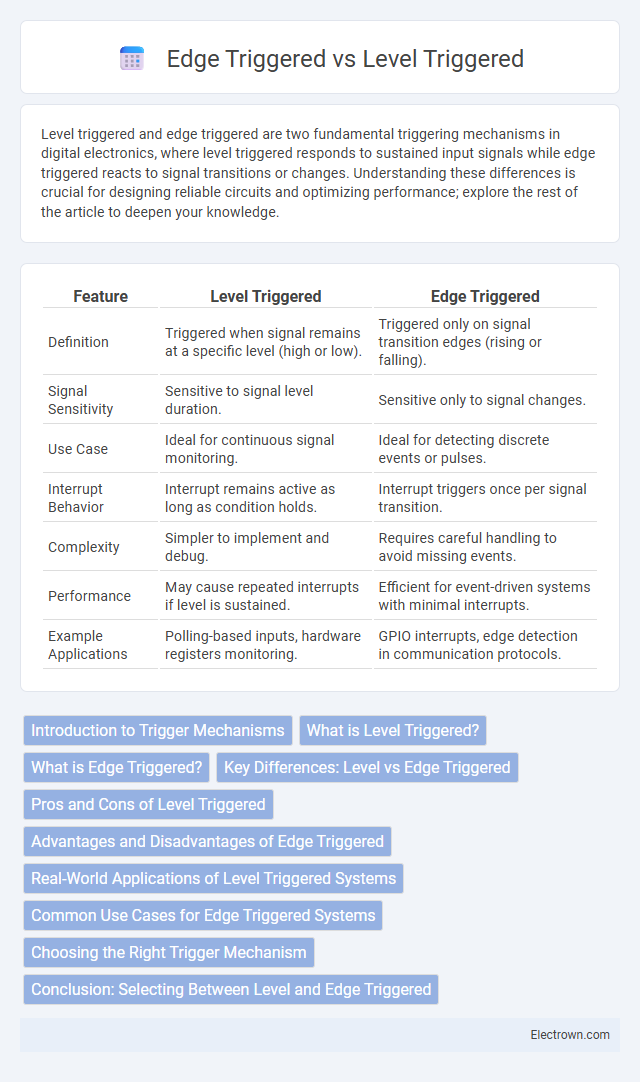Level triggered and edge triggered are two fundamental triggering mechanisms in digital electronics, where level triggered responds to sustained input signals while edge triggered reacts to signal transitions or changes. Understanding these differences is crucial for designing reliable circuits and optimizing performance; explore the rest of the article to deepen your knowledge.
Table of Comparison
| Feature | Level Triggered | Edge Triggered |
|---|---|---|
| Definition | Triggered when signal remains at a specific level (high or low). | Triggered only on signal transition edges (rising or falling). |
| Signal Sensitivity | Sensitive to signal level duration. | Sensitive only to signal changes. |
| Use Case | Ideal for continuous signal monitoring. | Ideal for detecting discrete events or pulses. |
| Interrupt Behavior | Interrupt remains active as long as condition holds. | Interrupt triggers once per signal transition. |
| Complexity | Simpler to implement and debug. | Requires careful handling to avoid missing events. |
| Performance | May cause repeated interrupts if level is sustained. | Efficient for event-driven systems with minimal interrupts. |
| Example Applications | Polling-based inputs, hardware registers monitoring. | GPIO interrupts, edge detection in communication protocols. |
Introduction to Trigger Mechanisms
Level triggered mechanisms respond to signals as long as the input remains at a specific logic level, ensuring continuous activation while the condition holds true. Edge triggered mechanisms detect changes or transitions in signals, such as rising or falling edges, and activate only at those precise moments. Understanding these trigger mechanisms helps optimize circuit designs by matching response sensitivity to your application's timing requirements.
What is Level Triggered?
Level triggered refers to a type of signal or event detection that remains active as long as the input signal is at a specific logic level, either high or low. This method continuously monitors the voltage state, allowing the system to respond to the presence of the signal during the entire duration of the level. Level triggered mechanisms are commonly used in hardware interrupts and polling systems to ensure reliable detection of steady-state conditions.
What is Edge Triggered?
Edge triggered refers to a type of signal detection in digital circuits where the response occurs only at the moment of a specific transition or edge, either rising (low to high) or falling (high to low), of the input signal. This method is commonly used in flip-flops and interrupts to capture changes precisely at the clock edge, enabling synchronous data transfer and reducing glitches. Edge triggered systems are crucial for sequential logic designs requiring accurate timing and state changes.
Key Differences: Level vs Edge Triggered
Level triggered circuits remain active as long as the input signal maintains a specific voltage level, enabling continuous response during this period and ensuring stable output for sustained signals. Edge triggered circuits activate only at the moment of a signal transition, such as a rising or falling edge, allowing precise detection of changes and minimizing sensitivity to signal duration. This fundamental distinction makes level triggered devices suitable for monitoring steady states, while edge triggered devices excel in capturing transient events and clock pulses in synchronous systems.
Pros and Cons of Level Triggered
Level triggered interrupts provide reliable detection by continuously monitoring the signal level until it is cleared, ensuring no events are missed during processing. They offer simpler hardware design and easier implementation in systems requiring sustained attention to an interrupt condition. However, level triggered interrupts can cause repeated interrupts if the condition persists, potentially leading to inefficiency and increased CPU usage.
Advantages and Disadvantages of Edge Triggered
Edge triggered mechanisms offer faster performance and reduced CPU utilization by responding only to signal transitions rather than constant levels. However, edge triggered interrupts risk missing signals if multiple events occur rapidly between polling intervals, leading to potential data loss or missed inputs. You should weigh the increased efficiency against the possibility of lost events when choosing edge triggered over level triggered designs.
Real-World Applications of Level Triggered Systems
Level triggered systems are widely used in real-world applications such as memory devices, including DRAM and SRAM, where stable signal levels are essential for reliable data storage and retrieval. Industrial control systems also employ level triggered mechanisms to maintain continuous monitoring and operation based on steady input signals rather than transient changes. These systems are preferred in scenarios requiring sustained signal recognition to prevent missed events or false triggering in noisy environments.
Common Use Cases for Edge Triggered Systems
Edge triggered systems are commonly used in high-speed digital circuits such as microprocessors and communication interfaces where precise timing is critical. They efficiently detect signal transitions, making them ideal for applications like pulse counting, interrupt handling, and clock synchronization. Your design benefits from edge triggering when you require accurate response to changes rather than continuous signal levels.
Choosing the Right Trigger Mechanism
Choosing the right trigger mechanism depends on your specific application requirements, with level triggered interrupts responding to a constant signal level and edge triggered interrupts detecting signal transitions. Level triggered triggers are ideal for devices that require continuous attention while level is active, ensuring no events are missed during signal assertion. Edge triggered triggers are more efficient for handling brief pulses or changes, reducing the risk of repeated interrupts and simplifying signal processing in high-speed systems.
Conclusion: Selecting Between Level and Edge Triggered
Choosing between level-triggered and edge-triggered mechanisms depends on your specific application needs: level-triggered is ideal for scenarios requiring continuous signal monitoring, while edge-triggered suits event-driven designs needing precise detection of signal changes. Level-triggered systems may risk repeated processing during signal persistence, whereas edge-triggered methods minimize this by responding only to transitions. Your selection should prioritize system responsiveness, resource efficiency, and signal behavior to optimize performance.
Level Triggered vs Edge Triggered Infographic

 electrown.com
electrown.com